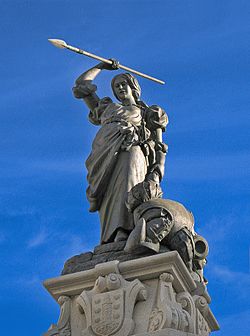m (Remove some templates and interwiki links, delink non military terms and cleanup, replaced: }} → }}, Image: → File:) |
(Remove some templates, interwiki links, delink non military terms and cleanup) |
||
| (One intermediate revision by the same user not shown) | |||
| Line 1: | Line 1: | ||
[[File:A Coruña. María Pita’s statue. Galicia (Spain).jpg|thumb|right|250px|Monument to Maria Pita, A Coruña]] |
[[File:A Coruña. María Pita’s statue. Galicia (Spain).jpg|thumb|right|250px|Monument to Maria Pita, A Coruña]] |
||
| − | '''María Mayor Fernández de Cámara y Pita''' (Sigrás, 1565–1643), known as María Pita, was a [[Galician People|Galicia]]n heroine in the defence of |
+ | '''María Mayor Fernández de Cámara y Pita''' (Sigrás, 1565–1643), known as María Pita, was a [[Galician People|Galicia]]n heroine in the defence of Coruña, [[northern Spain]], against an English [[Counter Armada|attack]] upon the Spanish mainland in 1589.<ref>[http://www.coruna.es/servlet/Satellite?c=Page&pagename=Especiales20%2FPage%2FEspeciales20-PortadaSeccion&cid=1196131744369&argIdioma=en House-Museum of María Pita (Spanish)]</ref> |
==Defence of Coruña== |
==Defence of Coruña== |
||
| Line 16: | Line 16: | ||
==External links== |
==External links== |
||
*[http://www.deportivo-la-coruna.com/page.php?cid=57 A Coruña - Historical Figures (English)] |
*[http://www.deportivo-la-coruna.com/page.php?cid=57 A Coruña - Historical Figures (English)] |
||
| + | |||
| ⚫ | |||
| + | |||
{{DEFAULTSORT:Pita, Maria}} |
{{DEFAULTSORT:Pita, Maria}} |
||
[[Category:1565 births]] |
[[Category:1565 births]] |
||
| Line 26: | Line 29: | ||
[[Category:16th-century Spanish women]] |
[[Category:16th-century Spanish women]] |
||
[[Category:17th-century Spanish women]] |
[[Category:17th-century Spanish women]] |
||
| ⚫ | |||
Latest revision as of 02:20, 2 November 2019

Monument to Maria Pita, A Coruña
María Mayor Fernández de Cámara y Pita (Sigrás, 1565–1643), known as María Pita, was a Galician heroine in the defence of Coruña, northern Spain, against an English attack upon the Spanish mainland in 1589.[1]
Defence of Coruña
On the 4th of May 1589, English forces, already in control of the lower city, breached the defences of the old city. Maria Pita was assisting her husband, an army captain manning the defences, when he was killed by a crossbow bolt that struck him in the head. An English soldier with a banner, who was making his way to the highest part of the wall, was killed by Pita. She appeared on the heights of the wall herself, shouting: Quen teña honra, que me siga ("Whoever has honour, follow me!") whereupon the English incursion was driven back by the defenders. The English later abandoned the siege and withdrew to their ships. Other women also participated directly in the defence of Coruña; a surviving record tells of one Inés de Ben receiving treatment for two shots received in the siege. Pita's heroic deeds were honoured and rewarded by Philip II, who granted her the pension of a military officer, which she received following the death of her husband who was killed during the battle.[2]
María Pita was married four times and had four children.
Spanish ships
- The ship María Pita of the Balmis Expedition was named after her in 1803.[3]
- In August 2008, SASEMAR (Sociedad de Salvamento y Seguridad Marítima, Spanish acronym for Sea Rescue and Safety Society) baptized the BS-14 Rescue Ship as María Pita.[4]
References
- ↑ House-Museum of María Pita (Spanish)
- ↑ Archivo General de Simancas. Memorial de 1596. Cámara de Castilla, atado 772.
- ↑ La Corbeta María Pita (Spanish)
- ↑ BS María Pita (Spanish) Archived 2011-07-08 at the Wayback Machine.
External links
The original article can be found at María Pita and the edit history here.